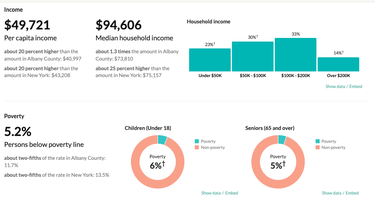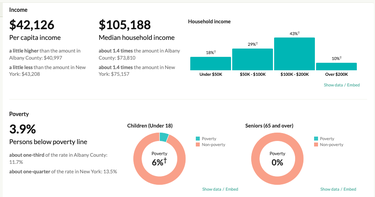Guilderland votes to administer Knox program for subsidized housing
Guilderland Town Board members expressed hope last week that some of the 200 families on the town’s waiting list for government-subsidized housing may soon get the help they have been waiting for.
Guilderland is working with the neighboring town of Knox to take over the administration of the slots Knox has in the Section 8 Housing Choice Voucher Program financed by the federal department of Housing and Urban Development.
On Sept. 19, the Guilderland Town Board voted unanimously in favor of a resolution to accept “the transfer of the administration of the Town of Knox’s Section 8 Housing Choice Voucher (HCV) Program.”
The Knox town board has yet to pass a parallel resolution.
Guilderland Councilwoman Amanda Beedle said of Knox, “They wanted to come to us because they weren’t getting utilized and, here in Guilderland, we could utilize them. So it’s a great benefit for the town of Guilderland and the residents waiting on that list,” said Beedle, noting no one had moved off the Guilderland waiting list in almost five years.
Councilman Jacob Crawford said he had been concerned “because there’s so many unmet needs in families in town.” He went on, “So this is amazing to be able to open up more opportunities this year.”
Crawford cited research he’d done that showed Guilderland was “excelling in comparison to some of the other suburban towns and in the Capital District.”
Knox’s supervisor, Russell Pokorny, told The Enterprise it was difficult to fill Knox’s slots for Section 8 because income-eligible candidates “can’t find housing in Knox — so they find it in surrounding communities.” Sometimes, he said, this is as close as Altamont — a nearby village in the town of Guilderland — and other times as far away as Coxsackie in Greene County.
“We currently have no one looking for Section 8 housing,” said Pokorny.
Asked why he thought this would be when there are certainly Knox residents who would meet the income requirements for the program, Pokorny said, “People give up finally.” He likened it to unemployment rolls going down not because people have found jobs but, rather, because they’ve stopped looking for work.
According to the United States Census Bureau, Guilderland, with a population of roughly 37,000, has a per capita income of $49,721 with 5.2 percent of its population below the poverty line while Knox, with a population of roughly 3,000, has a per capita income of $42,126 with 3.9 percent of its population below the poverty line.
Unlike the indications made by Guilderland Town Board members about the Knox slots soon being filled by Guilderland residents on that town’s waiting list, Pokorny said, “We are guaranteed it will still apply to people in Knox. That is part of the deal.”
He went on, “I don’t know why it would help them get people off their waiting list.” Rather, he said the advantage for eligible Knox residents is it would allow them to be subsidized to live in places in Guilderland.
He also suggested, “It might be a better economy of scale for Mastrianni to have one town instead of two to deal with.”
JEM Inc.
The programs for both towns are currently administered by JEM Inc., named for its founder Joseph E. Mastrianni but now owned by his son, James Mastrianni.
In a March presentation to the Guilderland town board, James Mastrianni said that Guilderland had 95 slots with the number of Housing Choice Vouchers set by a study in 1982.
JEM Inc. has a staff of 36 and administers 4,000 units of Housing Choice Vouchers in 15 counties across upstate New York, Mastrianni told the board in March.
The goal, he said, of HUD Section 8 housing is “to provide safe, sanitary, and decent housing for the elderly, the disabled, and the low-income members … of your community.”
Under the Housing Choice Voucher program, a subsidy is paid directly to a landlord based on the income of each family in the program. A family typically pays 30 percent of its adjusted gross income.
The program, Mastrianni said, allows elderly and disabled people to live near their families and near the services they require. It means a “working poor family” can move closer to where there are jobs compatible with their skills, he said.
Councilwoman Beedle had noted in March that, of the 91 families in Guilderland receiving the housing assistance, 86 of them are for elderly or disabled residents.
Councilman Crawford asked in March what the options are for families on the waiting list. “They’re either living with families or they’re, you know, living in a severely rent-burdened situation,” said Mastrianni.
The Knox Section 8 program was started in 1995, instigated by then-Councilman Nicholas Viscio. In looking back, in 2015, of his time on the Knox board, Viscio said setting up Section 8 housing for the town was one of the things he was proudest of.
This was because “it assists the elderly and struggling families …,” he said then. “It’s brought in over a million-and-a-half dollars — federal money, our tax dollars.”
The original grant was written for 15 units, according to Enterprise reporting at the time and, by 2000, Knox was allocated federal funds for up to 20. At the same time, seven Knox families were enrolled in a self-sufficiency program and one graduate of that program had already purchased a home.
On Sept. 19, Guilderland Supervisor Peter Barber said Knox has “approximately 15 allocations, meaning that, if they were to transfer those 15 to the town of Guilderland, we could use those here in our town.”
Pokorny set the number of Knox slots at 12.
Nancie Williams, Outreach and Home Program coordinator for JEM Inc., explained the reasons for some of the discrepancies to The Enterprise this week.
The number of units could vary, Williams said, depending on the portion of federal funds used for each family. “We pay a higher amount for lower incomes,” she said.
She noted, “HUD hasn’t increased allocations for vouchers for years.”
Williams went on, “HUD has asked us to look at programs and consolidate when it makes sense.”
She said it made sense to consolidate the administration of the programs in Guilderland and Knox — there are no other Hilltowns involved in the Section 8 program — because HUD could look at an underutilized program and could cut funding.
“Right now,” Williams said, “we have no applicants for Knox … No one is on the waiting list.”
Asked why this would be, Williams said there is a two-part test: People have to apply, and the town has to have rental housing.
Not enough people are applying in Knox and housing in Knox is largely owner-occupied — “you have a high rate of homeownership,” said Williams, as opposed to rental units.
“We proposed combining,” Williams said, explaining that Guilderland — through her agency — would take over administration of the program while people in Knox will still have access to the program, using available rental units in Guilderland as a resource.
She also explained, “Anybody, anywhere in the country can apply for Section 8; you can be on multiple lists …. Our goal is to make sure we’re preserving the funding for the area.”
She concluded that HUD allows consolidation only twice a year. “We’re hoping by the first of the year,” she said, to have transferred the administration of Knox’s program to Guilderland.



